大学英汉、汉英翻译教程(卢红梅主编)思维导图
- 格式:xmin
- 大小:6.28 KB
- 文档页数:1

考研英语翻译方法思维导图CONTENTS •introduction•Overview of English Translation Methods for Postgraduate Entrance Examination•The application of mind mapping in English translation forCONTENTS•Common errors and avoidance methods in English translation for postgraduate entrance exams•Practical Practice and Analysis of English Translation forintroduction01Cultivate translation thinking: Through learning and training, cultivate candidates' translationthinking, improve their sensitivity and expression ability to the English language.Improve the English translation ability of the postgraduate entrance examination: By learningand practicing various translation methods, improve the scoring ability of candidates in the English translation section of the postgraduate entrance examination.Response to exam requirements: Provide effective preparation strategies and methods for theEnglish translation section of the postgraduate entranceexamination, based on the exam requirements and scoring standards.Purpose and backgroundApplicable scopeGraduate English Exam CandidatesSuitable for all candidates taking the postgraduate English exam, especiallythose who need to achieve high scores in the translation section.English learnersIt also has certain reference value for English learners who hope to improve theirEnglish translation ability and language proficiency.Translation practitionersFor those engaged in translation work, practical translation methods and skillscan be provided to help them better complete translation tasks.Overview of English Translation Methods for Postgraduate Entrance02Literal translation methodWord translationPreserve the original words in the translation without violating the language norms of the original textand without causing erroneous associations.Structural transformationWhen the structure of English sentences is inconsistent with that of Chinese sentences, structuraltransformation is required to make the translation conform to Chinese expression habits.Omitting and supplementingAccording to Chinese expression habits, omit or supplement some redundant or missinginformation in the original text.Free translation methodWhen translating, pay attention to the fluency and readability of the translation to make it conform to Chinese expression habits.Keep the translation fluentWhen translating, the first step is to understand the deep meaning of the original text and the author's true intention.Understanding the meaning of the original textdon't stick to the words and structures of the original text, use words andstructures that conform to Chinese expression habits to express the original meaning.Get rid of the original formPersonal names, place names, brand names, and other proprietary terms: For such vocabulary, transliteration is generally used to express the original pronunciation in similar Chinese Some common vocabulary: In some cases, transliteration can also be used to enhance the readability and interest of the translation.Abbreviations and abbreviations: For suchvocabulary, transliteration can also be used toexpress the original pronunciation incorresponding Chinese characters. transliterationWhen translating, retain the image metaphors and rhetorical devices in the original text to make the translation more vivid and vivid.When the image in the originaltext cannot find a correspondingexpression in Chinese, themethod of image conversion canbe used to express the originalmeaning with an image thatconforms to Chinese expressionhabits.In some cases, in order to betterexpress the original meaning andenhance the expressive power ofthe translation, new imagemetaphors and rhetorical devicescan be created.Preserve the original image Image conversion Creating newimagesForm translation methodThe application of mind mapping in English translation for postgraduate03•Definition: A mind map is a graphical thinking tool that visualizes complex information and thinking processes through elements such as graphics, lines, and colors.characteristicVisualization: Using elements such as graphics and colors to make information more intuitive and easy to understand.Flexibility: Mind maps can be adjusted in structure and content as needed, making it easy for users to modify and improve. Structured: A mind map focuses on the central theme and radiates multiple sub themes outward, forming a clear hierarchical structure.Improving translation efficiency By using mind maps, one canquickly organize the structure of an article, locate key information, and improve translation speed and accuracy.要点一要点二Enhanced memoryeffectMind maps visualize important information and key points during the translation process, helping to deepen memory.Developing logical thinkingThe hierarchical structure of mind maps helps to cultivate the logical thinking ability of translators, making translation more accurate and fluent.要点三The advantages of mind mapping in translating English for postgraduate entrance examsHow to use mind maps to translate English for postgraduate entrance exams•Preparation: Familiarize oneself with the topic and backgroundknowledge of the article, understand relevant vocabulary andexpressions.•Create a mind map: Determine the central theme, which is the title orcore content of the article to be translated, and radiate multiple subthemes outward, including article structure, key information, importantvocabulary, etc.•Improve mind map: Gradually fill in each part of the mind mapaccording to the content of the article, add detailed information andrelated examples to make the mind map more rich and complete.•Using mind maps for translation: Based on the hierarchical structureand information prompts of mind maps, gradually translate to ensureaccuracy and fluency. At the same time, the mind map can be adjustedand improved at any time to adapt to changes in the translationprocess.Translation skills and strategies for postgraduate entrance examination04Carefully read the original text andunderstand the main idea and paragraphs of the article.Pay attention to the contextual meaning of vocabulary and avoid misinterpretation.Analyze sentence structure and grasp thelogical relationship between sentences.Understand the language styles of different literary genres, such as technology, literature,business, etc.9字9字9字9字Understand the original meaning and grasp the language styleChoose appropriate vocabulary and phrases to accurately express the original meaning.Use various sentence structures to make the translation more natural and fluent in expression.Pay attention to the collocation and usage of vocabulary, and avoid Chinglish.Maintain the coherence and consistency of the translation to avoid contradictions or repetition.Pay attention to selecting words and sentences, and maintain language fluency0102Omitting methodOmitting redundant or unnecessary information from the original text.Additional …Add necessaryvocabulary or phrases tomake the translationmore complete.TranslationmethodTransformingvocabulary or phrasesfrom the original textinto another form ofexpression.TranslationmethodSplit long sentencesinto multiple shortsentences to make thetranslation clearer andeasier to understand.Comprehensivemethodcomprehensively applythe above techniques tomake the translationmore accurate, fluent,and natural.030405Mastering translation skills to improve translation efficiencyCommon errors and avoidance methods in English translation for 0501 02 03Vocabulary errorsincluding confusion of word meanings, improper vocabulary combinations, etc.Grammar errorserrors in tense, voice, subject verb consistency, etc.Lack of cultural background knowledgeTranslation errors caused by lack of understanding of relevant cultural backgrounds.Common types of errorsError Cause AnalysisLack of solid language foundationInaccurate and proficient mastery of vocabulary and grammar.Lack of cultural background knowledgeInsufficient understanding of the cultural background in the relevant field.Improper translation skills and methodsLack of necessary translation skills and methods, resulting in low translationquality.Strengthen language basic training: improve vocabulary and grammar level, and enhance language perception ability.Expand culturalbackground knowledge:Widely read variousEnglish original works,newspapers andmagazines, etc., andaccumulate knowledge inrelated fields.Mastering translationskills and methods: Learnand master varioustranslation skills andmethods, such asaddition translation,omission translation,conversion method, etc.,to improve translationaccuracy and fluency.Do more practice andsimulation tests: Throughextensive practice andsimulation tests, improvetranslation speed andaccuracy, cultivatetranslation thinking andadaptability.Discussion on Avoidance MethodsPractical Practice and Analysis ofEnglish Translation for06•Review and Analysis of 2022 True QuestionsTitle OverviewTranslation difficulties and techniques Reference translation and rating•Review and Analysis of 2021 True QuestionsTitle OverviewTranslation difficulties and techniques Reference translation and rating•Trend analysis of past real test questionsReview and Analysis of Historical True Questions Change in question typeDistribution of examinationpointsDifficulty changesSimulated Question 1 Topic displayTranslation ideas guidance•Reference translation and self-evaluationSimulated Question 2Topic display Translation ideas guidance•Reference translation and self-evaluation•Simulated question threeTopic displayTranslation ideas guidanceReference translation and self-evaluationWord Meaning Selection Techniques Determine word meaning based on contextPay attention to the phenomenon of polysemy in a wordSentence structureanalysis techniquesIdentifyingsentencebackbone andmodifying Strategies for handling complex sentence patternsSkills for applying cultural background knowledge Understanding the culturaldifferences between Chinaand the WestProperly applyingbackground knowledge toassist translation谢谢您的聆听THANKS2024/1/2541。
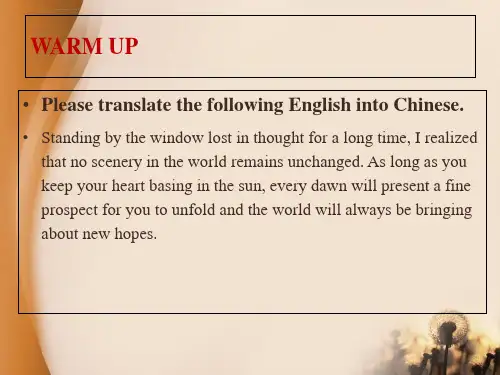
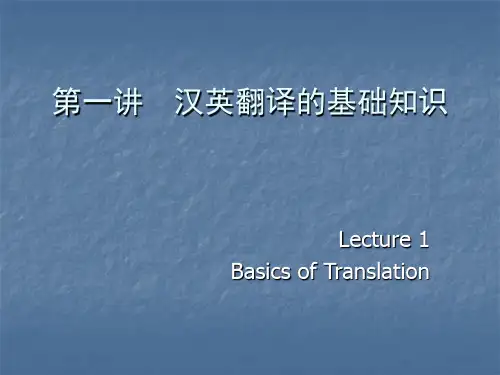
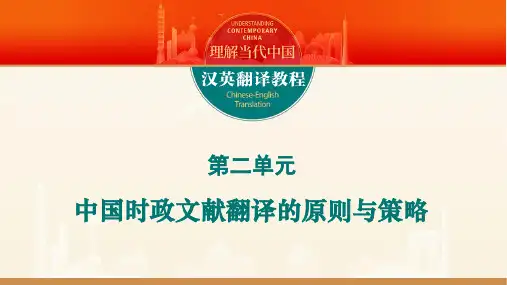
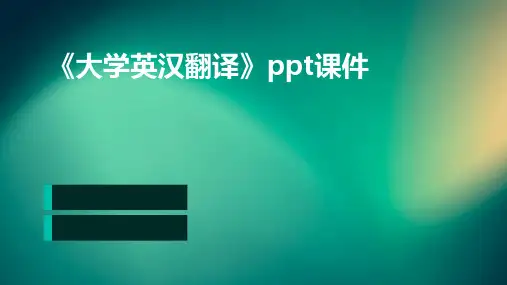
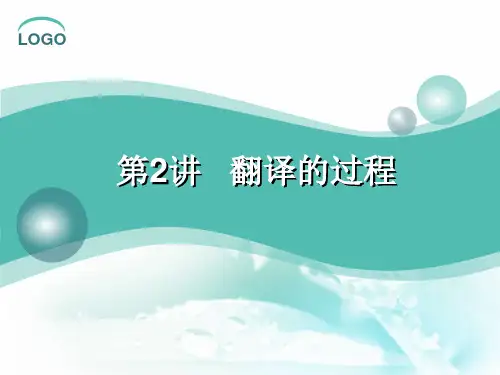
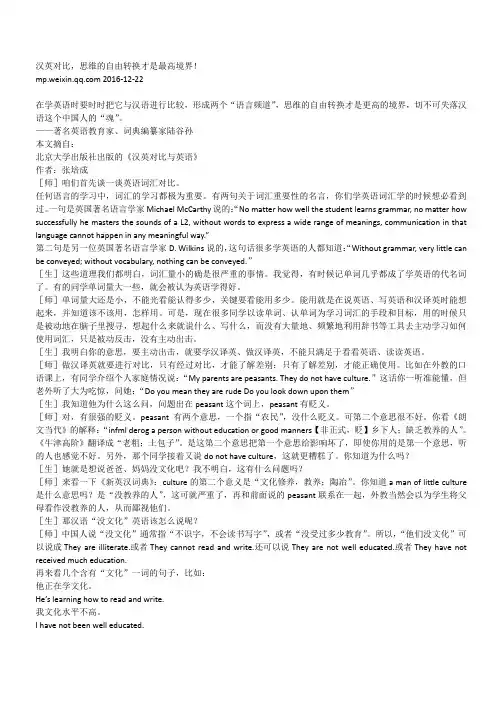
汉英对比,思维的自由转换才是最高境界! 2016-12-22在学英语时要时时把它与汉语进行比较,形成两个“语言频道”,思维的自由转换才是更高的境界,切不可失落汉语这个中国人的“魂”。
——著名英语教育家、词典编纂家陆谷孙本文摘自:北京大学出版社出版的《汉英对比与英语》作者:张培成[师]咱们首先谈一谈英语词汇对比。
任何语言的学习中,词汇的学习都极为重要。
有两句关于词汇重要性的名言,你们学英语词汇学的时候想必看到“No matter how well the student learns grammar, no matter how 过。
一句是英国著名语言学家Michael McCarthy说的:successfully he masters the sounds of a L2, without words to express a wide range of meanings, communication in that language cannot happen in any meaningful way.”第二句是另一位英国著名语言学家D. Wilkins说的,这句话很多学英语的人都知道:“Without grammar, very little can be conveyed; without vocabulary, nothing can be conveyed.”[生]这些道理我们都明白,词汇量小的确是很严重的事情。
我觉得,有时候记单词几乎都成了学英语的代名词了。
有的同学单词量大一些,就会被认为英语学得好。
[师]单词量大还是小,不能光看能认得多少,关键要看能用多少。
能用就是在说英语、写英语和汉译英时能想起来,并知道该不该用,怎样用。
可是,现在很多同学以读单词、认单词为学习词汇的手段和目标,用的时候只是被动地在脑子里搜寻,想起什么来就说什么、写什么,而没有大量地、频繁地利用辞书等工具去主动学习如何使用词汇,只是被动反击,没有主动出击。
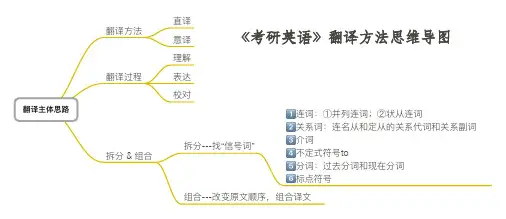
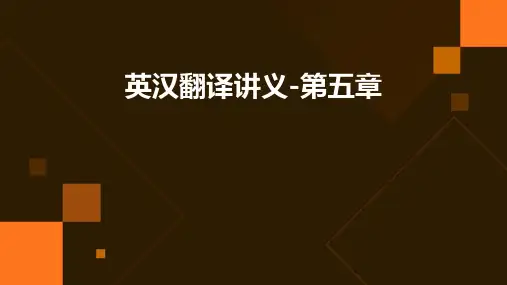
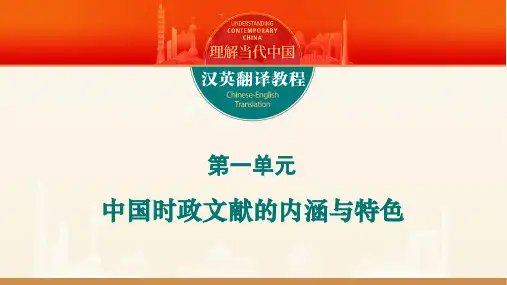

新世纪大学英汉翻译教程__上海交大毛荣贵教...一.英汉翻译理论与实践课程之教案目录第1讲“翻译”溯源第2讲翻译的本质第3讲翻译的标准第4讲翻译面面观第5讲翻译必有“失”/失于此而得于彼(两讲合并)第6讲翻译与联想第7讲翻译与语法第8讲翻译与语体第9讲翻译与语篇第10讲英汉十大差异第11讲形合与意合第12讲代词的困惑第13讲Connotation的翻译第14讲翻译与词典第15讲以“模糊”求精确第16讲落笔知轻重译文讲分寸第17讲翻译最难是口吻第18讲翻译与形象思维第19讲翻译与灵感思维第20讲英语修辞的翻译(包括连接三讲)第21讲翻译中的文化冲击第22讲思维是语言的脊梁(两讲合并)第23讲翻译美学之思考(两讲合并)二.汉英翻译理论与实践课程之教案目录第1讲汉译英呼唤文字功力第2讲语篇与翻译第3讲:英汉语美感比读(两讲合并)第4讲:理性概译:翻译之坦途第5讲:英语句式的亮点:非人称主语句(两讲合并)第6讲:汉译英有用的句型(两讲合并)第7讲:类析汉译英常见拙译(三讲合并)第8讲:从“湖光山色”的英译说开去(两讲合并)第9讲:Denotation和Connotation(两讲合并)第10讲:翻译,你的本质是什么?第11讲:归化与异化----汉语习语的英译一.英汉翻译理论与实践课程之练习第1讲“翻译”溯源试将下列文字译成汉语:1/Translation consists in reproducing in the receptor language the closest natural equivalent of the source language,first in terms of meaning and secondly in terms of style.(Eugene A.Nida& Charles R.Taber:The Theory and Practice of Translation,1969)2/Translation may be defined as follows:The replacement of textual material in one language(SL)by equivalent textual material in another language(TL)3/A translation should give a complete transcript of the ideas of the original work.The style and manner of writing should be of the same character as that of the original.A translation should have all the ease of the original composition.(A.F.Tytler:Essay on the Principles of Translation.1791)参考译文1/所谓翻译,是在译语中用最切近的自然的对等语再现原语的信息,首先是意义,其次是文体。
安菊梅(2006:) 《英汉翻译教程》重庆:重庆大学出版社包惠南包昂(2004:) 《中国文化与汉英翻译》北京:外文出版社常玉田(2005:) 《经贸英译汉教程》北京:外文出版社陈德彰(2005:) 《英汉翻译入门》北京:外语教学与研究出版社陈定安(2004:) 《翻译精要》北京:中国青年出版社陈宏薇(1996:) 《新实用汉译英教程》武汉:湖北教育出版社陈宏薇(1998:) 《汉英翻译基础》上海:上海外语教育出版社陈宏薇(2004:) 《新编汉英翻译教程》上海:上海外语教育出版社陈秋劲(2005:) 《英汉互译理论与实践》武汉:武汉大学出版社陈文伯(2004:) 《译艺——英汉汉英双向笔译》北京:世界知识出版社陈小慰(2006:) 《新编实用翻译教程》北京:经济科学出版社陈新(1999:) 《英汉文体翻译教程》北京:北京大学出版社程永生(2005:) 《汉译英理论与实践教程》北京:外语教学与研究出版社成昭伟(2006:) 《简明翻译教程》北京:国防工业出版社戴文进(2003:) 《科技英语翻译理论与技巧》上海:上海外语教育出版社丁菲菲(2004:) 《英汉互译理论与实践》武汉:武汉大学出版社丁树德(2005:) 《翻译技法详论》天津:天津大学出版社段云礼(2005:) 《新编商务英语翻译教程》天津:南开大学出版社范仲英(1994:) 《实用翻译教程》北京:外语教学与研究出版社方梦之(2004:) 《英汉-汉英应用翻译教程》上海:上海外语教育出版社方梦之(2005:) 《英汉翻译基础教程》北京:中国对外翻译出版公司冯庆华(2002:) 《实用翻译教程》上海:上海外语教育出版社傅敬民(2004:) 《当代高级英汉互译》上海:上海大学出版社傅敬民(2005:) 《英汉翻译辨析》北京:中国对外翻译出版公司傅晓玲(2004:) 《英汉互译高级教程》广州:中山大学出版社古今明(1997:) 《英汉翻译基础》上海:上海外语教育出版社顾维勇(2005:) 《实用文体翻译》北京:国防工业出版社郭富强(2004:) 《英汉翻译理论与实践》北京:机械工业出版社郭著章(1994:) 《英汉互译实用教程》武汉: 武汉大学出版社韩其顺(1990:) 《英汉科技翻译教程》上海:上海外语教育出版社郝丽萍(2006:) 《实用英汉翻译理论与实践》北京:机械工业出版社何刚强(2003:) 《英汉口笔译技艺》上海:复旦大学出版社何三宁(2005:) 《实用英汉翻译教程》南京:东南大学出版社华先发(2000:) 《新实用英译汉教程》武汉:湖北教育出版社华先发(2004:) 《新编大学英译汉教程》上海:上海外语教育出版社黄洋楼(2004:) 《英汉互汉实用技巧》广州:华南理工大学出版社江峰(2005:) 《实用英语翻译》北京:电子工业出版社靳梅琳(1995:) 《英汉翻译概要》天津:南开大学出版社居祖纯(1998:) 《汉英语篇翻译》北京:清华大学出版社居祖纯(2000:) 《高级汉英语篇翻译》北京:清华大学出版社居祖纯(2002:) 《新编汉英语篇翻译强化训练》北京:清华大学出版社居祖纯(2004:) 《汉英翻译强化训练》上海:上海辞书出版社柯平(1993:) 《英汉与汉英翻译教程》北京:北京大学出版社孔令翠(2002:) 《实用汉英翻译教程》成都:四川大学出版社李波阳(2005:) 《商务英语汉英翻译教程》北京:中国商务出版社李长栓(2004:) 《非文学翻译理论与实践》北京:中国对外翻译出版公司李建军(2004:) 《新编英汉翻译》上海:东华大学出版社李明(2006:) 《英汉互动翻译教程》武汉:武汉大学出版社李延林(2003a:) 《英汉文化翻译学教程》长沙:中南大学出版社李延林(2003b:) 《英汉文化翻译学实践教程》长沙:中南大学出版社李运兴(2003:) 《英汉语篇翻译》(第二版)北京:清华大学出版社李运兴(2006:) 《汉英翻译教程》北京:新华出版社连淑能(1993:) 《英汉对比研究》北京:高等教育出版社连淑能(2006:) 《英译汉教程》北京:高等教育出版社刘其中(2004:) 《》刘文捷(2004:) 《翻译入门——英译汉》成都:西南交通大学出版社卢红梅(2006:) 《华夏文化与汉英翻译》武汉:武汉大学出版社陆殿扬(上)陆殿扬(下)吕俊(1994:) 《英汉翻译的理论与方法》南京:河海大学出版社吕瑞昌(1983:) 《汉英翻译教程》西安:陕西人民出版社马秉义(2006:) 《汉译英基础教程》北京:中国对外翻译出版公司马会娟(2004:) 《商务英语翻译教程》北京:中国商务出版社毛荣贵(2003:) 《英译汉技巧新编》北京:外文出版社蒙兴灿(2005:) 《实用英汉翻译教程》成都:四川大学出版社潘红(2004:) 《商务英语英汉翻译教程》北京:中国商务出版社彭长江(2002:) 《英汉汉英翻译教程》长沙:湖南师范大学出版社邵志洪(2003:) 《翻译理论、实践与评析》上海:华东理工大学出版社申雨平戴宁(2002:) 《实用英汉翻译教程》北京:外语教学与研究出版社司显柱曾剑平(2006:) 《汉译英教程》上海:东华大学出版社隋荣谊(2004:) 《汉英翻译新教程》北京:中国电力出版社隋荣谊(2004:) 《英汉翻译新教程》北京:中国电力出版社孙致礼(2003:) 《新编英汉翻译教程》上海:上海外语教育出版社谭卫国(2005:) 《新编英汉互译教程》上海:华东理工大学出版社谭云杰(2003:) 《实用汉译英教程》长沙:湖南大学出版社王大伟(1999:) 《现代汉英翻译技巧》上海:世界图书出版公司王大伟(2005:) 《汉英翻译技巧教学与研究》北京:中国对外翻译出版公司王恩冕(2004:) 《大学英汉翻译教程》北京:对外经济贸易大学出版社王宏印(2002:) 《英汉翻译综合教程》大连:辽宁师范大学出版社汪涛(2006:) 《实用英汉互译技巧》武汉:武汉大学出版社王武兴(2003:)《英汉语言对比与翻译》北京:北京大学出版社王治奎(1999 EC:) 《大学英汉翻译教程》济南:山东大学出版社王治奎(1999 CE:) 《大学汉英翻译教程》济南:山东大学出版社魏志成(2004:)《英汉比较翻译教程》北京:清华大学出版社温秀颖(2001:) 《英语翻译教程(英汉·汉英)》天津:南开大学出版社翁凤翔(2002:) 《实用翻译》杭州:浙江大学出版社肖君石(1982:) 《汉英、英汉翻译初探》北京:商务印书馆萧立明(2004:) 《英译汉规则与技巧》北京:机械工业出版社许建平(2003:) 《英汉互译实践与技巧》北京:清华大学出版社阎佩衡(2005:) 《英汉与汉英翻译教学论》北京:高等教育出版社颜洪恩(1994:) 《翻译理论与实践》昆明:云南人民出版社杨莉藜(1993:) 《英汉互译教程》开封:河南大学出版社叶子南(2001:) 《高级英汉理论与实践》北京:清华大学出版社余富林(2003:) 《商务英语翻译(英译汉)》北京:中国商务出版社曾城(2002:) 《实用汉英翻译教程》北京:外语教学与研究出版社张蓓(2001:) 《汉英时文翻译实践》北京:清华大学出版社张春柏(2003:) 《英汉汉英翻译教程》北京: 高等教育出版社张培基(1980:) 《英汉翻译教程》上海:上海外语教育出版社张新红(2003:) 《商务英语翻译(英译汉)》北京: 高等教育出版社张彦李师君(2005:)《商务文体翻译》杭州: 浙江大学出版社赵桂华(2003:) 《翻译理论与技巧》哈尔滨:哈尔滨工业大学出版社周志培(2003:) 《汉英对比与翻译中的转换》上海:华东理工大学出版社朱徽(2004:) 《汉英翻译教程》重庆:重庆大学出版社朱宪超韩子满(2006:) 《译员基础教程》北京:中国对外翻译出版公司庄绎传(2002:)《英汉翻译简明教程》北京:外语教学与研究出版社。
英汉互译中语篇衔接的特点和用法作者:姚琦来源:《河南农业·综合版》 2013年第22期河南农业职业学院姚琦摘要:在英汉互译中,识别原文语篇的衔接手段是至关重要的。
要做好英汉语篇的翻译,必须首先了解英汉语篇的表层结构——衔接。
分析语篇衔接的目的是发现语篇的发展模式,借助对语篇表层结构特征和深层结构特征的描述和解释,寻找语篇衔接的内在规律性。
衔接是将篇章中的句子连接为一个整体的重要手段,它帮助英语学习者建立句子边界之间的联系,从而建构连贯的篇章。
在英汉互译中,语篇衔接为英语翻译者们提供了一个较为具体的操作方法,也是英语教学中不可缺少的一部分。
关键词:语篇;衔接;语法;词汇在英汉互译中,由于英汉句子结构不一样,翻译者们常常发现衔接是个很难掌握的知识点。
因为英汉两种语言的衔接手段是不一样的,它们的表达方式存在较大差异。
句型方面:英语是种“形合”的语言,句子多以SVO的形式出现,但汉语是种“意合”的语言,可以省略主语,多个无主句可以排列在一起;句内关系方面:英语中逻辑联系词使用频率高,但汉语常不用关联词,而依靠句内各部分之间的内在逻辑关系达到连接的目的;照应方面:英语中有定冠词,英语人称代词及其相应的限定词的使用频率也大大高于汉语。
一、语篇衔接的理论依据衔接是符号学和语言学的重要概念,涉及“将一组句子生成文本的形式成分与原则”。
衔接既是连接句子的重要方式,也是文本通顺、语义连贯的重要保证。
被衔接的句子及其成分之间存在语义关系是衔接的基础。
语篇是一个语义单位,在语言学中是指任何长度的、语义完整的段落,语篇中的意义关系通过衔接手段联系起来。
语篇是实际使用的语言单位,是一次交际过程中的一系列连续的话段或句子所构成的语言整体。
语篇中各成分之间在形式上是衔接的,在语义上是连贯的。
著名语言学家韩礼德把英语语篇的衔接手段分为两大类:语法衔接和词汇衔接。
语法衔接手段包括照应、替代、省略和连接,而词汇衔接手段包括重述和搭配。